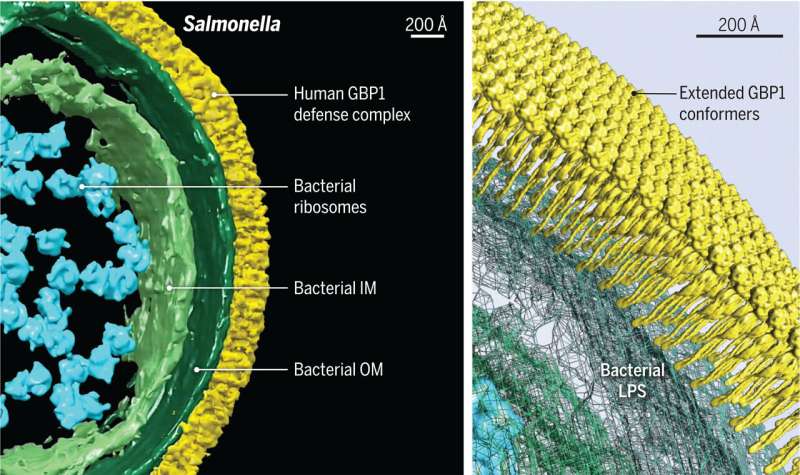This article has been reviewed according to Science X's editorial process and policies. Editors have highlighted the following attributes while ensuring the content's credibility:
fact-checked
peer-reviewed publication
trusted source
proofread
Discovery of 'molecular machine' brings new immune therapies a step closer

Yale scientists have discovered a family of immune proteins, which they describe as a "massive molecular machine," that could affect the way our bodies fight infection.
Our immune system mobilizes numerous proteins to detect viruses and bacteria—and to bring them under control. But until recently, limits to research technology have thwarted scientists' understanding of how to prevent different pathogens from occupying and replicating within specific parts of our cells in the first place.
Harnessing the latest cryo‐electron microscopy techniques to look inside human cells, researchers at the Yale Systems Biology Institute have identified a family of large immune proteins that assemble into a massive signaling platform directly on the surface of microbial pathogens.
The findings, published March 1 in the journal Science, are a significant step towards understanding how host-pathogen platforms are initiated and organized, and with it the potential for new medical applications to control infection, researchers say.
"What we found is among the most impressive examples of a biological machine in action that I've ever seen," said John MacMicking, a professor of microbial pathogenesis and of immunobiology at Yale, and an Investigator of the Howard Hughes Medical Institute. MacMicking is senior author of the study.
"These proteins come together on the surface of a bacterium to perform distinct biological functions that trigger our innate immune response to infection."
Guanylate Binding Proteins, or GBPs, were discovered by MacMicking's team over a decade ago as major organizers of intracellular host defense. They provide host protection against a broad array of bacteria, viruses, or parasites in both animals and plants.
But until now, most light and conventional electron microscopes have limited scientists to studying biological samples at comparably lower resolutions.
Using new cryo- and electron microscopy technology—which allows researchers to effectively freeze whole live cells and subject them to electron beams to capture high resolution structures in images called tomograms—the Yale team observed GBPs assembling on pathogens that had entered the watery liquid (or cytosol) inside cells.
The researchers say they found thousands of GBPs building what amounted to a coat of armor (GBP1 coat complex) around the bacteria, allowing other defense proteins to recognize and kill encapsulated bacteria as well as mobilize immune cells for protection.
"The Krios cryo-electron microscope at Yale's West Campus gives us the opportunity to push the boundaries of resolution and look at protective immune structures within cells in the search for knowledge underlying human disease," said MacMicking, who is a faculty member at the Yale Systems Biology Institute located at the West Campus.
The MacMicking Lab focuses on the biological question of how all nucleated cells—irrespective of tissue origin—protect themselves against infection.
"We are literally observing Mother Nature at work, looking at how these proteins operate in 3-dimensional space and at a particular location," said MacMicking. "In just a few minutes they unfold and insert into the bacterial membrane to form a truly remarkable nanomachine and innate immune signaling platform."
Through a better understanding of how GBPs function, the MacMicking Lab is turning its attention to identifying small molecules for new drugs that can inhibit or promote protein activity to tackle infection.
"That's the ultimate proof-of-principle—to find a medical application that is helpful and has real implications for human health," MacMicking said.
More information: Shiwei Zhu et al, Native architecture of a human GBP1 defense complex for cell-autonomous immunity to infection, Science (2024). DOI: 10.1126/science.abm9903
Journal information: Science
Provided by Yale University





















